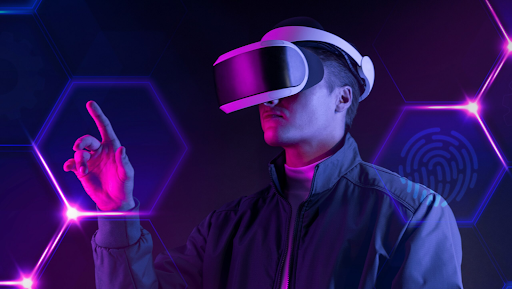Introduction
In the wake of Facebook rebranding as Meta, reflecting its attention to the “metaverse,” Microsoft has now introduced it, too, and will launch into this space. This article will present how the Metaverse will be huge, particularly in crypto, virtual reality, gaming, and NFT spaces.

Source: artlabs.ai
What is the Metaverse?
The Metaverse is the digital world where anything we can imagine can exist. Eventually, we’ll be connected to the Metaverse all the time, extending our senses of sight, sound, and touch, blending digital items into the physical world, or popping into fully immersive 3D environments whenever we want. That family of technologies is known collectively as eXtended Reality (XR).
The Metaverse will entail experiences such as; assisted reality, augmented reality, meatspace, multiverse, and virtual reality.
AI and the Metaverse
One of the most critical aspects of the Metaverse will be AI. The Metaverse will be enabled, populated by, and supported with artificial intelligence (AI). Some of the use-cases include;
-
Interface Optimization
Computers are continuously getting better at gesture recognition, which will enable us to interact more naturally with computers, eventually interpreting and understanding emotion and body language.
-
AI for Chip Design
Chips are getting harder to design with the computing power needed to support the exponentially increasing demands of the Metaverse. AI will help to solve this. Google is already stepping ahead in this with the chip placement with deep reinforcement learning.
-
AI as Creative Partner
AI systems will get to know us over time and shape our experience of the Metaverse accordingly.
The Cryptocurrency Connection
Cryptocurrencies will allow us to rally behind a shared Metaverse and pay for the services required to support it without a single entity owning all the resources.
A number of projects have adapted to take on the Metaverse to augment its application, for example, using the Metaverse in crypto gaming. The Sandbox is one of the leading projects with the purpose of constructing the Metaverse to combine the virtual world with the world of gaming seamlessly.
Why the Metaverse Needs Crypto, NFTs, and Open Standards
A decentralized economy is fairer, more efficient, and more long-term sustainable than trusting any single company with the keys to the Metaverse. In the cryptoverse, everyone gets to access and control their own spaces.
The Metaverse consists of many parts, but there are some basic foundations. The Metaverse will need;
-
decentralized ledgers and smart contract platforms
The Metaverse will need decentralized ledgers and smart contract platforms for transparent, permissionless, and censorship-resistant transactions for public viability.
-
eXtended Reality (XR) hardware
eXtended reality encapsulates; Augmented Reality (AR), Virtual Reality (VR), Mixed Reality (MR) hardware such as smart glasses, haptics, omni treadmills, etc.
-
Open programming language standards
Such standards include JavaScript, WebXR, WebAssembly, WebGPU Shader Language, HTML, etc.
-
Open standards for media
Such as; text, images, audio, video, 3D items and scenes, vectors, sequences, and procedures to generate and combine any of these things. Pixar’s USD and NVIDIA’s MDL are great steps towards interoperability for 3D applications.
What are some of the leading Metaverse Projects?
The Metaverse will need a massive technological infrastructure, ranging from computing power to edge computing to 3D imaging to content to finance and commerce systems. And, as the Metaverse is seen as the next iteration of the internet, every company that has an internet presence will want to stake a claim in the Metaverse as well.
The Metaverse feels like it is some years away from reaching its full fruition, but a group of visionaries think of it as the future of the internet and believe that you can invest in it now. The group y teamed up with Roundhill Investments to register a Metaverse ETF, an exchange-traded fund (ETF), or securities that trade on an exchange, just like stocks. This particular ETF lets people invest in companies that are either already making the Metaverse happen or are positioned to participate in the future. The fund has now surpassed $250 million in assets under management.
Some of the top holdings in the exchange are:
- Nvidia Corporation
- Microsoft Corp.
- Roblox Corp.
- Facebook Inc.
- Unity Software Inc.
- Snap, Inc.
- Autodesk Inc.
- Amazon Com Inc.
- Tencent HLDGS LTD
- Sea LTD
Apple, Intel, Qualcomm, Alphabet, Coinbase, Electronic Arts, Samsung, Adobe, Alibaba, Disney, PayPal, and Square are also in the fund.
Some of the leading metaverse projects include;
-
Decentraland (MANA)
Decentraland was among the first and most established Metaverse built on the Ethereum blockchain. It is a virtual world where users can buy, develop, and sell LAND, a non-fungible ERC-721 token representing virtual land ownership in the Decentraland. Here, each parcel of LAND is unique, and owners get to choose what content they want to publish on their portion land, such as an interactive game. Users purchase LAND as well as all other goods and services in Decentraland with MANA, a fungible ERC-20 token.
-
Enjin Coin (ENJ)
The Enjin Network is a gaming community platform that boasts over 20 million users. Enjin began building a suite of blockchain products that enable anyone to easily manage, explore, distribute, and integrate blockchain assets. Just last week, Enjin announced that they had formed a $100 million fund to support projects in its ecosystem geared toward developing a decentralized metaverse.
Enjin’s latest project is MetaverseMe, which allows you to create an accurate digital representation of yourself, that is generated directly from a selfie via a mobile app. Using cutting-edge Augmented Reality (AR), MetaverseMe lets you record your avatar experiencing the world, while rocking your favorite digital fashion pieces. These recordings can afterwards be shared on social platforms.
-
Sandbox
Sandbox is a virtual world where players build, own, and monetize gaming experiences using NFTs. Players create digital assets in the form of NFTs, upload them to the marketplace, and integrate them into games using The Sandbox Game Maker.
The Sandbox virtual world is made up of LAND, which are digital pieces of real estate in The Sandbox metaverse that players can buy and build virtual experiences on them.
-
Opensea
OpenSea was the first decentralized non-fungible token (NFT) marketplace for buying, selling, and trading NFTs. Besides digital art, Opensea lists collectibles, game items, domain names, even digital representations of physical assets. OpenSea is touted as an eBay for NFTs with millions of assets organized into hundreds of categories.
-
Flow
Flow, touted as the blockchain for open worlds, is a fast, decentralized, and developer-friendly blockchain that is designed as the foundation for a new generation of games, apps, and the digital assets that power them. Flow is based on a multi-role architecture and designed to scale without sharding, allowing for massive improvements in speed and throughput while preserving a developer-friendly, ACID-compliant environment.
Final thoughts
The Metaverse is a construct of a virtual world enabled by Virtual Reality (VR) and Augmented reality (AR) technologies to improve the convenience and realism of connecting users. As a result, many industries, new and established, are interested in applying the Metaverse to its business.







